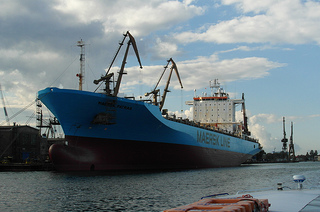 Following the rejection last month by Chinese maritime regulators of the proposed P3 alliance, Maersk, Mediterranean Shipping Co. (MSC), and CMA CGM could resort to further slow steaming between Asia and Europe under pressure to find alternative ways to cut costs.
Following the rejection last month by Chinese maritime regulators of the proposed P3 alliance, Maersk, Mediterranean Shipping Co. (MSC), and CMA CGM could resort to further slow steaming between Asia and Europe under pressure to find alternative ways to cut costs.
Drewry predicts that the slow-steaming approach could be the next option for the three box lines as a way to reduce bunker costs, which account for well over half of all running costs of vessels.
One of P3’s biggest savings was supposed to come from carrying almost the same amount of cargo between Asia and Northern Europe with only eight sailings a week instead of nine. And to the Mediterranean, five loops were planned instead of six.
The implication is that 11 of the carriers’ small vessels of 9,000 twenty-foot-equivalent units (TEUs) would have been cascaded out of the Asia-Northern Europe trade, and another 11 vessels of around 8,000 TEUs out of the Mediterranean.
Many of the displaced vessels, in turn, could have been transferred to other trade routes where further economies of scale are possible, such as the trans-Pacific.
By slow steaming, or lengthening the round voyage time, of each existing weekly service between Asia and Europe by seven days through adding one vessel, Maersk, MSC, and CMA CGM could effectively “lose” 15 surplus vessels while awaiting the cargo growth for which these vessels were ordered.
For example, the 9,400-TEU CMA CGM Danube has just been delivered, and will soon be deployed in CMA CGM and Maersk’s jointly run BEX service between Asia and the Black Sea.
Had P3 been allowed, removing a 9,000-TEU vessel a week between Asia and Northern Europe would have saved its members about US$155 million annually in bunker costs alone, according to Drewry’s calculations.
On the other hand, by lengthening the westbound and eastbound transit times of the three carriers’ existing nine weekly loops between Asia and Northern Europe by three and four days, respectively (through adding one vessel), the annual bunker cost saving would amount to around $264 million, according to Drewry’s calculations.
In the Mediterranean, eliminating one 8,000-TEU vessel a week would have saved its members another $94 million annually in bunker costs alone, whereas by lengthening the westbound and eastbound transit times of the three carriers’ six existing weekly loops by three and four days respectively, the annual bunker cost saving would amount to around $132 million.
But while the financial benefit of the service eliminations between Asia and Europe originally envisaged by P3 would have all gone to its members, some of the savings resulting from increased slow steaming would have to be passed back to shippers via reduced bunker surcharges.
Ignoring the split, and assuming an average vessel utilization of 85 percent from Asia to Europe, and 65 percent on the way back, the three carriers and their customers together would save about $45 per TEU on every box shipped during the speed reduction program, said Drewry.
Also, the key to making the savings is having enough surplus vessels in the right place at the right time, which may not be possible with slow steaming, added the research group.
MSC only shares vessels with CMA CGM between Asia and Northern Europe, and Maersk only shares vessels with CMA CGM in the Mediterranean, so there is no overall coordinating center to simplify planning in this respect, which would be illegal.
Moreover, slow steaming is not a win-win situation for carriers and shippers, said Drewry. It said many shippers claim that cost reductions from carriers’ slow steaming ultimately cost them more through the need to maintain higher inventory costs, and so they would resist such a plan.
Photo: seezenboot




